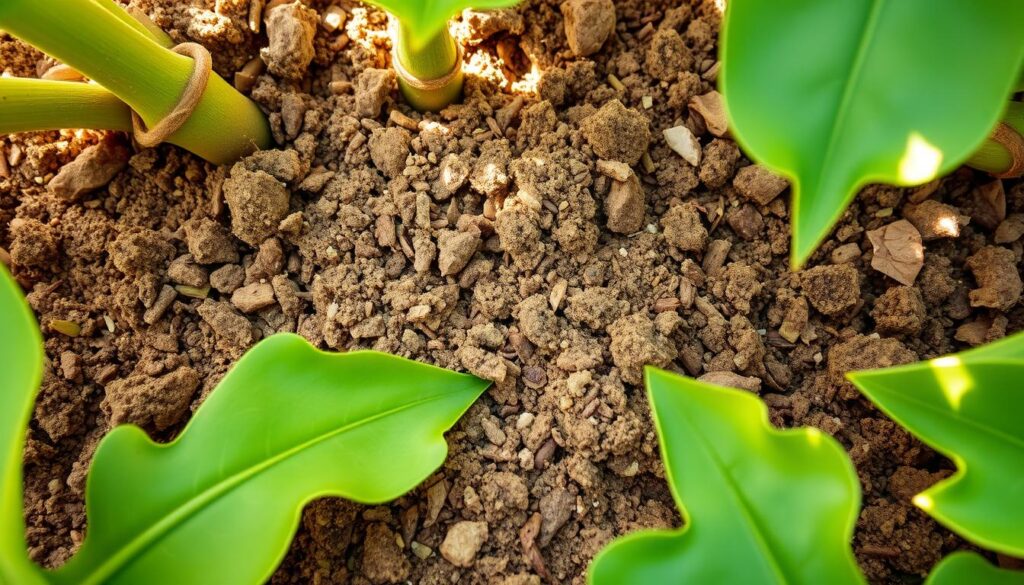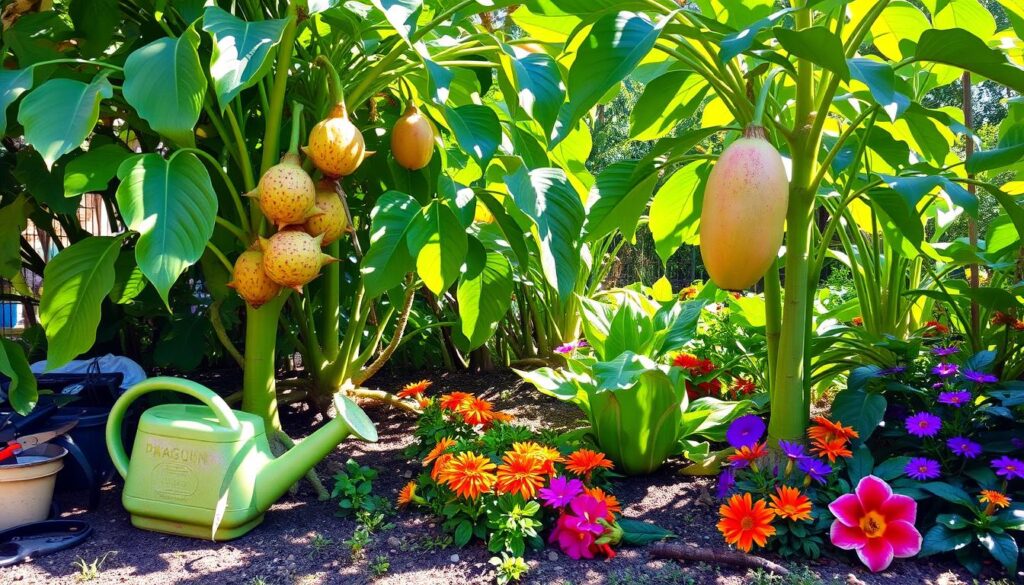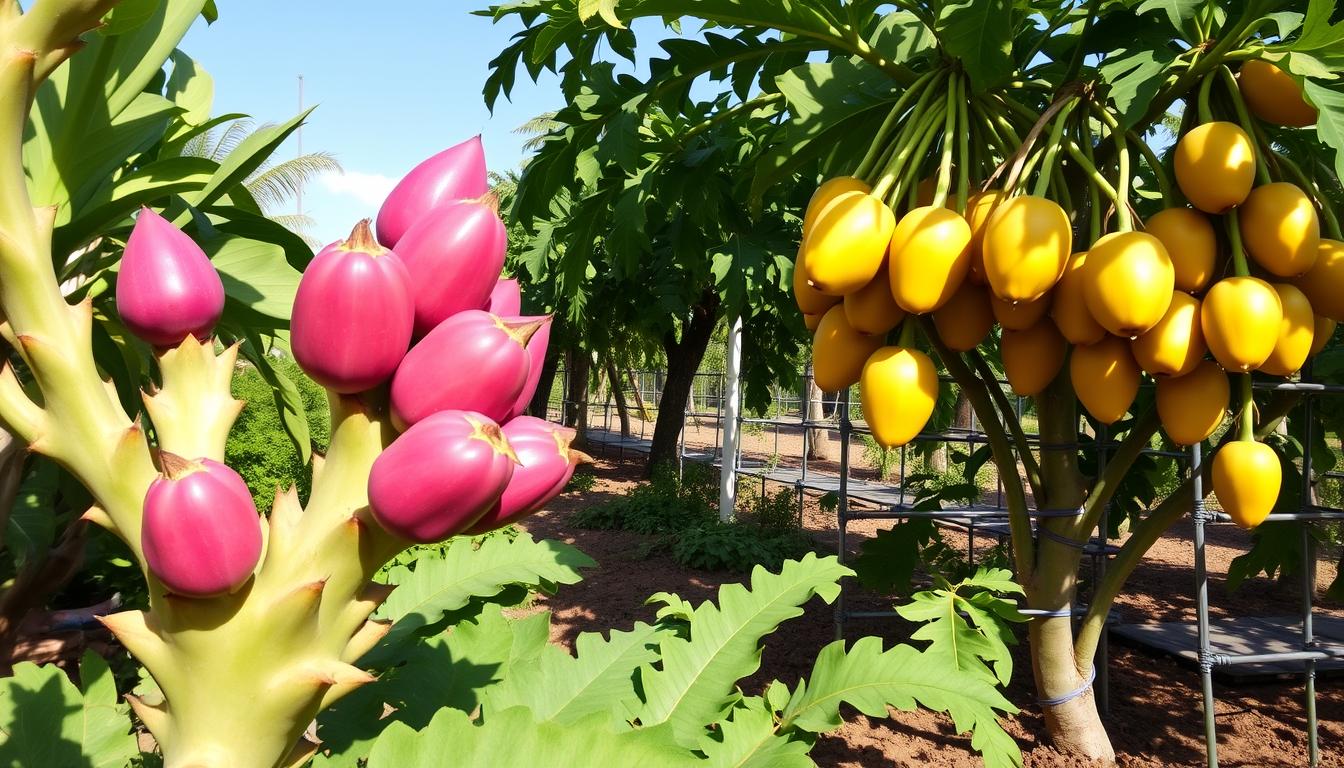As a gardening enthusiast, I find exotic fruit cultivation fascinating. Dragonfruit and papaya are especially intriguing. These tropical fruits are not only beautiful but also offer great health benefits. Dragonfruit, part of the Cactaceae family, has striking colors and a high nutritional value. Papaya is known for its sweet taste and health perks.
In this guide, I’ll share key insights and exotic fruit cultivation tips. These tips will help you grow these stunning fruits with confidence. We’ll learn how to grow exotic fruits like dragonfruit and papaya. This will turn your gardening dreams into a fruitful reality. For more resources and expert guidance, visit GardenBeginner.com.
Key Takeaways
- Dragonfruit is not only aesthetically pleasing but also packed with nutrients.
- Understanding the unique needs of each fruit can optimize growth.
- Papaya is an excellent choice for nutritious home gardening.
- Effective propagation methods greatly increase your success rates.
- Exploring innovative cultivation methods can enhance your yield.
- Proper maintenance is essential for a fruitful harvest.
- Community resources can offer invaluable support for beginner gardeners.
Understanding Exotic Fruits and Their Benefits
Exotic fruits, like dragonfruit and papaya, offer unique tastes and health perks. They add variety to our diets and boost our well-being. Growing rare fruits at home is a rewarding hobby that supports organic farming and local biodiversity.
Health Benefits of Tropical Fruits
Dragonfruit is a great example, with 57 calories per 100 grams. It’s rich in fiber, offering 11% of our daily needs. Dragonfruit also has antioxidants that help our hearts stay healthy.
It has omega-3 and omega-9 fats, which lower bad cholesterol. This makes it good for our hearts. Red dragonfruit might even fight cancer cells, especially in breast cancer.
Its anti-inflammatory effects could help with chronic pain from conditions like rheumatoid arthritis. Plus, it’s low in calories, helping with weight loss by keeping us full.
Why Grow Exotic Fruits at Home?
Growing exotic fruits at home gives us control over our gardening. It ensures we have fresh, organic produce right in our yards. It also makes gardening more exciting.
With more people focusing on healthy living, having these fruits at home is a plus. It lets us try new recipes and share with loved ones.
Growing our own fruits also helps the environment. It supports biodiversity in our gardens. For more tips on gardening, check out useful resources and tips.
Choosing the Right Variety of Dragonfruit
Choosing the right dragonfruit variety is key to success in tropical fruit farming. Each variety has its own taste and growing needs. You’ll find white, red, purple, and yellow dragonfruits, each with its own look and flavor.
Popular Species of Dragonfruit
The table below shows the popular dragonfruit species and their special features:
| Variety | Appearance | Taste Profile | Size |
|---|---|---|---|
| White Dragonfruit (Hylocereus undatus) | Creamy white flesh, speckled with black seeds | Less sweet, mild flavor | Larger, heavier |
| Red Dragonfruit (Hylocereus polyrhizus) | Bright pink skin with red or pink flesh | Higher sugar content, berry-like sweetness | Varies |
| Purple Dragonfruit (Hylocereus guatemalensis) | Bright magenta exterior with pinkish-purple flesh | Moderate sweetness, unique flavor | Intermediate |
| Yellow Dragonfruit (Selenicereus megalanthus) | Canary-yellow skin with occasionally translucent white flesh | Smaller, sweeter taste | Small |
Factors to Consider When Selecting a Variety
When picking a dragonfruit variety, consider these factors for selecting varieties:
- Climate adaptability: Choose varieties that fit your local climate.
- Growth habits: Some need more space or support to grow.
- Fruiting patterns: Pick varieties that fruit at the right time for you.
- Skin and flesh characteristics: Look for vibrant skin and healthy flesh for the best taste.
This dragonfruit growing guide helps you make informed choices. By thinking about these factors, you can pick the best dragonfruit for your farm.
How to Grow Exotic Fruits Like Dragonfruit and Papaya
Growing exotic fruits like dragonfruit and papaya needs careful attention. They thrive in warm climates and need lots of sunlight. Preparing the right conditions is key to growing these fruits successfully.
Understanding the soil needs for dragonfruit and papaya is crucial. It has helped me grow them well.
Essential Growing Conditions for Success
For both dragonfruit and papaya, light and warmth are essential. Here are important factors to consider:
- Choose a sunny location, as both fruits prefer full sun exposure.
- Ensure good air circulation to promote healthy plant growth.
- Implement trellising or support structures for dragonfruit to prevent overgrowth and structural damage.
- Monitor nearby plants to avoid competition for nutrients, as dragonfruit’s roots can extend into neighboring areas.

Soil Requirements and pH Level
Knowing the soil needs for dragonfruit and papaya is vital. They need well-draining soil to prevent root rot and diseases. Key aspects include:
- A pH level between 6.0 and 7.5 is ideal for growth.
- Avoid waterlogged conditions, which can be detrimental to the plants.
- Consider using 20-gallon or 40-gallon pots to provide ample space for root development.
- It’s advisable to anchor the plants in the pots with sturdy structures, such as a heavy post, for additional support.
By focusing on these soil conditions and gardening techniques, I can grow strong dragonfruit and papaya plants. They will yield plenty of fruit.
Papaya Cultivation: Ideal Conditions for Growth
Learning about the needs for growing papayas is key for those into tropical fruit farming. The right conditions are vital for healthy growth and a good harvest. This part talks about the best climate and nutrients for papaya trees to thrive.
Climate and Temperature Preferences
Papaya plants love warm weather, best between 70°F and 90°F. This range is perfect for seed germination, which happens at 70-85°F. Seeds sprout in 2-4 weeks after planting.
Seedlings need 6-8 hours of sunlight daily. For container growing, a five-gallon pot or bigger is best for their growth.
Watering and Nutritional Needs
Watering and feeding papayas right is crucial for their growth. Keeping the soil moist is key for young trees. A 2-3 inch layer of organic mulch helps keep moisture in.
In the first year, fertilize every two months. Use a nitrogen-rich fertilizer for growth. Older trees get a single spring fertilizer. Always check for pests like fruit flies and mealybugs to avoid infestations.
| Aspect | Ideal Conditions |
|---|---|
| Temperature | 70°F – 90°F |
| Sunlight | 6-8 hours/day |
| Pot Size for Containers | 5 gallons or larger |
| Watering Frequency | Regularly, maintain moisture |
| Fertilization | Every 2 months in first year; once in spring afterward |
| Mulch | 2-3 inch organic layer |
| Pest Inspection | Regularly for fruit flies, mealybugs, etc. |
Dragonfruit Growing Guide: Cultivation Techniques
The dragonfruit, also known as pitaya, is a tropical delight gaining popularity in home gardens. My guide focuses on propagation techniques for dragonfruit, covering seeds and cuttings. Each method has its own benefits and challenges, affecting cultivation success.
Propagation Methods: Seeds vs. Cuttings
Stem cuttings usually offer faster results than seeds. Let’s dive into both methods:
- Seeds: Dragonfruit seeds need soaking in water for 24 hours before planting. Plant them about 1/4 inch deep. This method takes longer, often 5-7 years for the plant to mature and produce fruit.
- Cuttings: For stem cuttings, choose segments 12-18 inches long with at least three nodes. This method is quicker, with fruit production starting in 2-3 years.
Best Practices for Planting and Spacing
Good planting techniques are key for dragonfruit growth. Here are my top tips for planting:
- Plant in a spot that gets full sun for 6-8 hours daily.
- Space plants 2-3 feet apart to improve airflow and reduce disease risk.
- Use sandy or loamy soil with a pH of 6 to 7.5 for best root growth.
- Feed with a balanced fertilizer, like 10-10-10 or 14-14-14, every two to three months during the growing season.
- Water deeply, letting moisture reach the roots, but avoid overwatering to prevent root rot.
By following these tips, you can greatly increase your chances of growing dragonfruit successfully. With the right propagation techniques and care, you’ll enjoy harvesting fresh dragonfruit in a few years.
The Importance of Plant Care and Maintenance
Caring for dragonfruit and papaya plants is key to a good harvest. It’s important to water them regularly and fertilize them correctly. I share tips on how to keep these exotic fruits healthy and thriving.
Watering Strategies and Fertilization
Dragonfruit plants need water every one to two weeks. Make sure not to overwater to avoid root rot. For tropical fruit trees, water deeply but less often. Adjust the amount based on the plant’s size and weather.
Papaya trees in containers do well with a balanced fertilizer. Use one with more potassium every 4-6 weeks during the growing season.
Start fertilizing after the first summer or year of planting. Use a fertilizer with less nitrogen and more phosphorus for dragonfruit. This helps with fruit production. Make sure the fertilizer reaches the roots for best results.
Common Pests and Diseases to Watch For
Watch out for pests like aphids, mealybugs, and scale insects. These pests love warm weather and can harm both dragonfruit and papaya plants.
Also, keep an eye out for diseases like root rot and fungal infections. Good air circulation and dry leaves can help prevent these. Early detection and action are key to keeping your plants healthy.

| Plant | Watering Frequency | Fertilization Recommendations | Common Pests |
|---|---|---|---|
| Dragonfruit | Every 1-2 weeks | Low nitrogen, high phosphorus; after the 1st year | Aphids, Mealybugs, Scale insects |
| Papaya | Deep, infrequent for established trees | Higher potassium; every 4-6 weeks | Aphids, Thrips |
By following a good care plan, you can grow healthy dragonfruit and papaya plants. For more tips, check my privacy policy.
Harvesting and Storing Exotic Fruits
Mastering the art of harvesting exotic fruits is key. Knowing when to pick dragonfruit and papaya is crucial for their taste and quality. Proper storage after harvest also extends their freshness. Here, I share my effective methods.
When and How to Harvest Dragonfruit
Harvest dragonfruit when its skin is bright and slightly soft. This is usually three to four days after it blooms. Use clean shears to cut the fruit without harming the plant.
Be gentle when handling dragonfruit, as it bruises easily. After picking, wash it lightly and let it dry before storing.
Proper Storage Techniques for Papaya
Pick papayas when they are mostly yellow or orange. Store unripe papayas in a cool, dark spot. Once ripe, refrigerate to keep it fresh.
Use a breathable container to prevent moisture buildup. These simple steps help keep your fruits fresh longer.
For more tips on harvesting tropical fruits, check out this article. It offers detailed techniques and advice.
Exotic Fruit Cultivation Tips for Beginners
Starting to grow exotic fruits like dragonfruit and papaya is exciting and rewarding. With the right advice, growing tropical gardens can be a success. Here are some tips for beginners to start your gardening journey.
Starting Your Own Tropical Fruit Garden
To start your tropical fruit garden, follow these steps:
- Select a Suitable Location: Pick a spot with lots of sunlight and good air flow. Dragon fruit loves full sun after getting used to it.
- Prepare the Soil: Use sandy, slightly acidic soil with a pH of 6 to 7 for dragon fruit. Make sure the soil drains well to avoid root rot.
- Acclimate Your Plants: Introduce dragon fruit plants to sunlight slowly over two weeks to avoid sunburn.
- Water Wisely: Water consistently during the growing season, but less in winter.
Tools and Supplies You Will Need
For successful fruit gardening, you’ll need some essential tools and supplies:
- Gardening Gloves: Keep your hands safe while gardening.
- Shovel and Trowel: Use these for planting and soil care.
- Watering Equipment: Have a way to water consistently, like a hose or drip system.
- Fertilizers: Choose high-quality fertilizers to help plants grow.
- Pruning Shears: These are key for keeping plants healthy and promoting new growth.
With these tips and tools, beginners can grow a thriving tropical garden. Enjoy the journey and enjoy the fruits of your labor!
| Tool | Purpose |
|---|---|
| Gardening Gloves | Protect your hands while gardening. |
| Shovel | For digging and moving soil. |
| Trowel | Perfect for smaller planting tasks. |
| Watering Equipment | Ensures proper irrigation. |
| Fertilizers | Supports healthy growth and fruiting. |
| Pruning Shears | Essential for trimming and promoting growth. |
Innovative Cultivation Methods for Exotic Fruits
In today’s urban environment, growing exotic fruits in small spaces is possible. Vertical gardening techniques make the most of limited areas. They allow for growing fruits like dragonfruit and papaya without needing a lot of land.
This method promotes healthy growth. Plants get enough sunlight and air. It’s a great way to grow fruits in tight spaces.
Vertical Gardening Techniques for Limited Spaces
Vertical gardening is perfect for small yards or apartments. It uses wall planters, trellises, or vertical frames. This way, you can create a green space without using a lot of ground.
Here are some techniques I’ve found to work well:
- Wall Planters: Plant climbing fruits like dragonfruit on wall planters.
- Trellises: Trellises support heavy plants and let them get more sunlight.
- Stacked Planters: You can stack containers in different sizes for various plants.
Hydroponic Systems for Dragonfruit and Papaya
Hydroponics is another way to grow exotic fruits. It uses water with nutrients instead of soil. This method helps dragonfruit and papaya grow faster and stronger.
I’ve set up my hydroponic system to include:
- Drip Hydroponics: A drip system gives plants nutrients consistently for better growth.
- Deep Water Culture: Plants in water grow fast and get more oxygen.
- Structural Support: Support systems help plants carry the weight of growing fruits.
Using these methods, I can grow exotic fruits efficiently, even in small areas. The results are amazing. I enjoy the fruits and see how popular these methods are becoming in urban farming.
Conclusion
Growing exotic fruits like dragonfruit and papaya is a rewarding journey. It requires understanding their growth needs and offers unique flavors. This article covered key factors such as climate, soil, and care for these tropical fruits.
Success in growing exotic fruits comes from patience and attention. Dragonfruit, for example, takes up to two years to fruit from cuttings. Seeds can take even longer.
Dragonfruit’s blooming schedule is interesting. Flowers open at night and stay open for just one evening. This makes hand pollination crucial for fruit production.
Pruning and protecting plants from wildlife are important. These steps help improve plant health and yield. Young dragonfruit needs protection from frost, a key topic in gardening circles.
Exploring exotic fruit cultivation is an exciting adventure. I encourage you to join this vibrant journey. With patience and the right techniques, you can create a garden full of tropical flavors and health benefits.



Leave a Reply